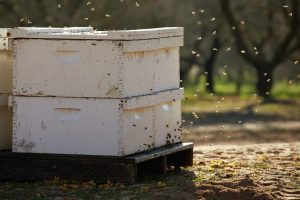In California, winter and spring 2023 will be remembered for the rain and cold and its effect on almond bloom and pollination. The weather also had a dramatic effect on pollinators, Billy Synk, habitat specialist for Pollinator Partnership, said.
“It was a different year; flight hours for bees were reduced, yet pollination happened in some orchards, while not in others,” Synk said. “The weather had a dramatic effect on managed and native pollinators.”
On a positive note, Gene Brandi, a Los Banos-area commercial beekeeper and former president of the American Beekeeping Federation, said the 2023 winter and spring rains provided managed bees and native pollinators with a great deal of natural forage that had not been available since 2019. He said bees were able to produce sage, buckwheat, toyon and other honeys in the spring and early summer. Abundant bluecurl and tarweed plants emerged and have been supplying pollen and nectar during the later summer and early fall period, which greatly helps with bees’ nutritional needs as colonies prepare for the winter.
“Wet years are generally good years for bees in California as long as hives don’t get flooded or washed away,” Brandi said.

Steve House, master beekeeper and director of operations for California Almond Pollination Service Inc., said many California beekeepers recorded record honey production this year due to abundance of natural and planted forage. In addition, he said most beekeepers also reported 30% to 50% more bees were produced than in previous years.
“Colonies were healthier and productive and were also able to combat mites and various viruses. Good nutrition helped bees survive and tolerate disease and mites,” House said.
USDA-NASS Survey
A USDA-NASS survey from August 2023 reported that honeybee colonies added to operations with more than five colonies from January to March was 384,790. During the quarter from April to June, 573,160 colonies were added, the highest number of honeybee colonies added for any quarter surveyed in 2022. The number one stressor for managed bees throughout the U.S. the USDA report noted, was varroa mites with 50% of colonies affected through June. There was also an increase in bee colonies lost to Colony Collapse Disorder nationwide. The survey represented 12% of the estimated 2.70 million managed honey-producing colonies in the U.S. in 2022.
House said he believes the 2024 pollination season should be good for almond growers with adequate supplies of strong colonies expected.
He did note that demand for pollination services may be less due to orchard removals. A USDA report shows California almond acreage decreased in 2022 for the first time in more than 25 years, despite a slight increase in bearing acres. House said he is seeing growers shrink their hive count per acre to 1.5 hives, down from two.
In addition to the increase on natural pollinator forage due to the wet winter, more acres of planted cover crops in orchards and adjacent areas have contributed to bee health. House said he is planning to plant cover crops the first week of October.
“All our bee yards from Chico to Tulare County have bee forage crops planted to provide nutrition prior to and after almond bloom, House said.
As growers look ahead to the next growing season, Synk said many are adopting cover cropping and other practices that encourage bee activity and health.
Cold, wet weather, disease and mites all affect beehive strength, but Synk maintains the biggest threat to pollinator health is the lack of abundant and diverse nutrition.
“Pathogens, pesticides and sickness are always threats, but the thing that affects bee colonies is nutrition. Arriving in almond orchards early in the year, bees may not have access to forage. Beekeepers provide supplemental pollen to hold them until bloom, but Synk compared that to eating a candy bar for breakfast and expecting strong, growing hives at bloom.
At bloom, he said a growing population of bees is desired for successful pollination. Growing hives have a higher ratio of worker bees to ‘in-hive’ bees. Growers may be overpaying for pollination services when hives are only at medium strength. Strong, 11- to 12-frame hives deliver more bees for the money.
Stetcyn Maldonado, program manager for Seeds for Bees, said pollination in 2024 will depend heavily on how managed honeybees overwinter this year. Many out-of-state beekeepers move hives into California for pollination, but Maldonado said large weather events including Florida hurricanes or drought can reduce colony numbers. She also noted a record number of applications to the Seeds for Bees program this year, and there may be more than 20,000 acres enrolled.
Best Management Practices
Almond Board of California’s (ABC) Honeybee Best Management Practices stress early communication between beekeepers, bee brokers, growers and applicators. The concern is how to manage the use of pest control materials to minimize potential impact on honeybees and other pollinators. County agriculture commissioners recommend hive registration in the Bee Where program by beekeepers. This allows applicators to see hive locations within a one-mile radius of a planned spray application and provides contact information for notifications. ABC notes that all pollination stakeholders should note that the 1-mile buffer is not complete protection as bees can forage for up to 4 miles away from hives to collect food and find water sources.
Josette Lewis, ABC’s chief scientific officer, adds that “almonds and bees are really a partnership designed by nature. Bees are an essential input to growing almonds and, in return, honeybee hives leave almond orchards in the spring with more bees than they came in with. We can see how much almond growers recognize the value of pollinators by the efforts in the last few years that growers have made to add more pollinator habitat and forage in and around orchards, habitat that benefits all pollinators, not just honeybees.
About 170,000 acres of almonds have been certified as Bee Friendly Farms, and we have seen planting of pollinator specific cover crops increase by three-fold in just a few years.”
To further enhance pollinator habitat and managed bee health, Blue Diamond Growers recently announced a partnership program that includes offering almond growers no-cost cover crop seed and financial incentive for implementing cover crops or conservation cover on their land. Growers will work with Pollinator Partnership and Project Apis m. Blue Diamond also noted more than 15% of their growers’ orchards are certified in the Pollinator Partnership’s Bee Friendly Farming program.
This program is overseen by a task force of experts from the North American Pollinator Protection Campaign (NAPPC) including scientists and farmers and sets standards for planting pollinator food resources, providing nesting habitat and incorporating an integrated pest management strategy.











